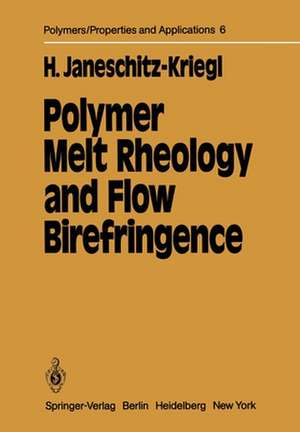Polymer Melt Rheology and Flow Birefringence: Polymers - Properties and Applications, cartea 6
Autor Hermann Janeschitz-Kriegl Editat de Joachim Meissneren Limba Engleză Paperback – 6 dec 2011
Preț: 656.25 lei
Preț vechi: 772.05 lei
-15% Nou
Puncte Express: 984
Preț estimativ în valută:
125.58€ • 131.38$ • 104.31£
125.58€ • 131.38$ • 104.31£
Carte tipărită la comandă
Livrare economică 03-17 aprilie
Preluare comenzi: 021 569.72.76
Specificații
ISBN-13: 9783642688249
ISBN-10: 3642688241
Pagini: 544
Ilustrații: XV, 524 p.
Dimensiuni: 170 x 244 x 29 mm
Greutate: 0.86 kg
Ediția:Softcover reprint of the original 1st ed. 1983
Editura: Springer Berlin, Heidelberg
Colecția Springer
Seria Polymers - Properties and Applications
Locul publicării:Berlin, Heidelberg, Germany
ISBN-10: 3642688241
Pagini: 544
Ilustrații: XV, 524 p.
Dimensiuni: 170 x 244 x 29 mm
Greutate: 0.86 kg
Ediția:Softcover reprint of the original 1st ed. 1983
Editura: Springer Berlin, Heidelberg
Colecția Springer
Seria Polymers - Properties and Applications
Locul publicării:Berlin, Heidelberg, Germany
Public țintă
ResearchCuprins
1 Survey of Experimental Results.- 1.1 Preparatory Considerations.- 1.2 Flow Birefringence Measurements.- References of Chapter 1.- 2 Quasi-Molecular Phenomenological Theories.- 2.1 Rubber Elasticity.- 2.2 The Linear Stress-Optical Relation.- 2.3 The Most Simple Rubberlike Liquid Model.- 2.4 More General Discussion of Quasi-Linear Models.- 2.5 Quasi-Linear Models Containing Adjustable Elements.- 2.6 A Theory Derived from a Different Basic Principle.- References of Chapter 2.- 3 Prospects for Predictions on a Moleculat Basis.- 3.1 General Introduction.- 3.2 Relaxion Processes in a Polmer Melt.- 3.3 General Flow Behavior of Polymer Melts.- References of Chapter 3.- 4 Industrial Applications.- 4.1 Molecular Orientation.- 4.2 Injection Moulding.- References of Chapter 4.- Appendix A: Linear Visco-Elasticity.- A.1 Hooke’s Law in Complex Notation.- A.2 Stress Relaxation and Creep.- A.3 Elastico-Viscous Flow and Recovery.- A.4 Some Comments with Respect to the Interconversion of Material Functions.- A.5 Mechanical Spectra.- A.6 Interconversion Formulae Based on the Relaxation Time Spectrum.- A.7 Calculation of the Relaxation Time Spectrum from Experimental Material Functions.- References of Appendix A.- Appendix B: The Time-Temperature Superposition Principle.- B.1 Introduction.- B.2 The WLF-Equation.- B.3 The Free Volume Concept.- B.4 Unified Description of the Temperature Denpendence of the Zero-Shear Viscosity.- References of Appendix B.- Appendix C: The Measurement of Birefringence Effects.- C.1 Matrix Representation of Optical Components.- C.2 Calculations of Intensities of Beams Emerging from the Analyser.- C.3 How to Cope with Imperfections of Windows and Polarizing Prisms.- C.4 Description of the Modulator.- C.5 Problems with Quickly Changing Birefringence Effects.-References of Appendix C.























